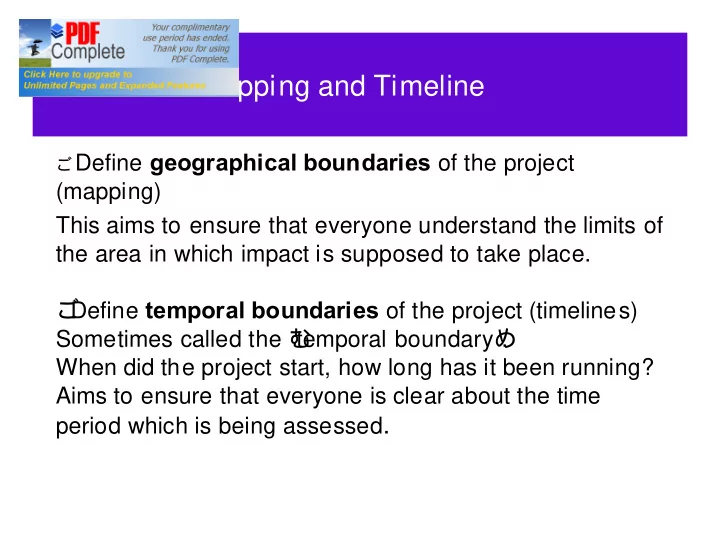

Session 3. Mapping and Timeline � Define geographical boundaries of the project (mapping) This aims to ensure that everyone understand the limits of the area in which impact is supposed to take place. � Define temporal boundaries of the project (timelines) Sometimes called the � temporal boundary � . When did the project start, how long has it been running? Aims to ensure that everyone is clear about the time period which is being assessed .
Specific objectives: � To collect information required to design a PIA study of an intervention from local people who participated the implementation process � To triangulate information obtained from key informant groups or individual informants e.g. event vs. intervention both in terms of space and time � To answer questions related to attributions and causalities e.g. other organizations interventions vs. changes perceived from the PIA study
How to facilitate mapping exercise e.g. � Explain your information need to the inf ormants about the kind of maps to produce and the kind of map you are expecting them to prepare � Select appropriate place to draw maps � Let them decide about symbols to be used for di fferent variables � Use the maps to generate further discussion by asking questions when maps are complete � Register all useful inf ormation during the discussion � Copy the maps drawn clearl y and accurately
Define the project boundary geographically
How to facilitate timeline exercise e.g. � Explain the objective of the exercise � Establish time reference together with informants � Ask major events that have been happening during this period and then the sequence of the key events identified
Define the project period - timelines Telalak 1986 Prosopis introduced by Natural Resource and Wildlife Protection Organization of the former government 1991 Downfall of Derg Livestock deaths due to disease called sole and drought 1992 1993 Boya-hagay in which a large number of livestock deaths remembered Massive camel deaths occurred due to goson or kahu 1994 NGO 1995 Woder-Temere Gillal in which massive death of goats has occurred in project which the kraal was left empty due to gublo and korboda diseases started Good rain and milk, life was good; waybo comes for the first time in 1996 Afar and killed many cattle 1998 School, clinic and water reservoir construction started by SATCON and people were being employed as daily labourer and get a lot of money Lahibiak (swelling) around the neck (Anthrax?) has occurred and killed over 100 people NGO 1999 Some of their herders were selected to be trained as CAHWs project 2000 Human health clinic started functioning ended 2001 Second round CAHWs selection occurred 1992 Extensive farming initiated by private investors and government
Group Exercise � Animal Health Project area � VSF Swiss mapping � Animal Health services interventions and disease situation over a longer period of time Time = you will have 60 minutes
Recommend
More recommend